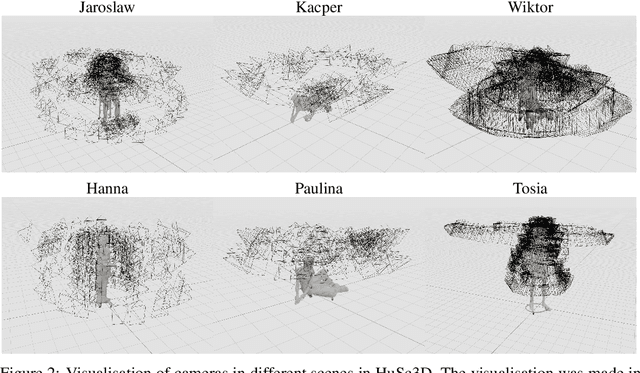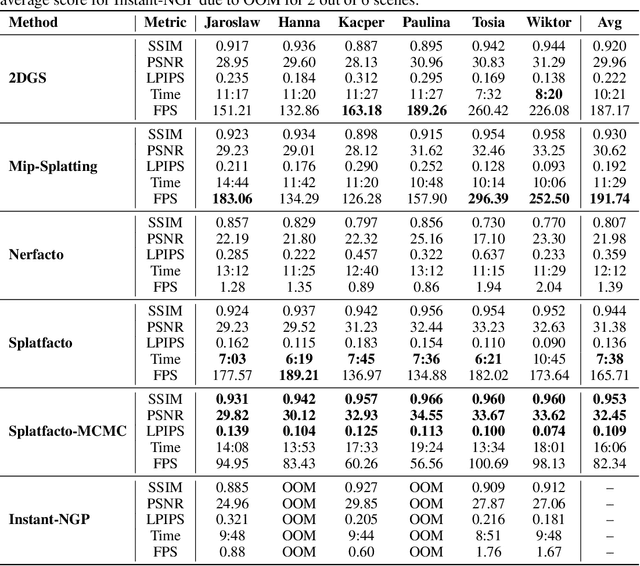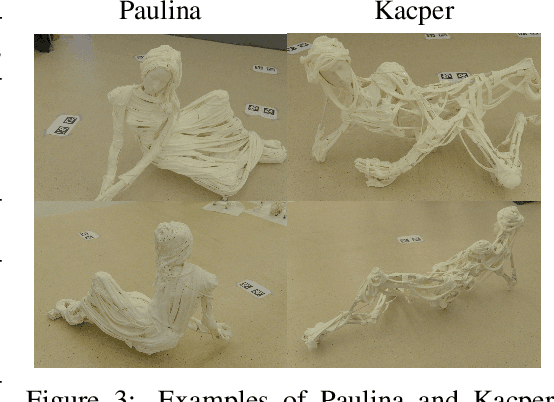Przemysław Spurek
HuSc3D: Human Sculpture dataset for 3D object reconstruction
Jun 09, 2025



Abstract:3D scene reconstruction from 2D images is one of the most important tasks in computer graphics. Unfortunately, existing datasets and benchmarks concentrate on idealized synthetic or meticulously captured realistic data. Such benchmarks fail to convey the inherent complexities encountered in newly acquired real-world scenes. In such scenes especially those acquired outside, the background is often dynamic, and by popular usage of cell phone cameras, there might be discrepancies in, e.g., white balance. To address this gap, we present HuSc3D, a novel dataset specifically designed for rigorous benchmarking of 3D reconstruction models under realistic acquisition challenges. Our dataset uniquely features six highly detailed, fully white sculptures characterized by intricate perforations and minimal textural and color variation. Furthermore, the number of images per scene varies significantly, introducing the additional challenge of limited training data for some instances alongside scenes with a standard number of views. By evaluating popular 3D reconstruction methods on this diverse dataset, we demonstrate the distinctiveness of HuSc3D in effectively differentiating model performance, particularly highlighting the sensitivity of methods to fine geometric details, color ambiguity, and varying data availability--limitations often masked by more conventional datasets.
SHIELD: Secure Hypernetworks for Incremental Expansion Learning Defense
Jun 09, 2025



Abstract:Traditional deep neural networks suffer from several limitations, including catastrophic forgetting. When models are adapted to new datasets, they tend to quickly forget previously learned knowledge. Another significant issue is the lack of robustness to even small perturbations in the input data. In practice, we can often easily perform adversarial attacks and change the network's predictions, adding minimal noise to the input. Dedicated architectures and training procedures can solve each of the above problems separately. Unfortunately, currently, no model can simultaneously address both catastrophic forgetting and vulnerability to adversarial attacks. We introduce SHIELD (Secure Hypernetworks for Incremental Expansion and Learning Defense), a novel approach that integrates a hypernetwork-based continual learning approach with interval arithmetic. SHIELD use the hypernetwork to transfer trainable task embedding vectors into the weights of a target model dedicated to specific data. This paradigm allows for the dynamic generation of separate networks for each subtask, while the hypernetwork aggregates and analyzes information across all tasks. The target model takes in the input a data sample with a defined interval range, and by creating a hypercube, produces a prediction for the given range. Therefore, such target models provide strict guarantees against all possible attacks for data samples within the interval range. Our approach enhances security without sacrificing network adaptability, addressing the overlooked challenge of safety in continual learning.
CLIPGaussian: Universal and Multimodal Style Transfer Based on Gaussian Splatting
May 28, 2025Abstract:Gaussian Splatting (GS) has recently emerged as an efficient representation for rendering 3D scenes from 2D images and has been extended to images, videos, and dynamic 4D content. However, applying style transfer to GS-based representations, especially beyond simple color changes, remains challenging. In this work, we introduce CLIPGaussians, the first unified style transfer framework that supports text- and image-guided stylization across multiple modalities: 2D images, videos, 3D objects, and 4D scenes. Our method operates directly on Gaussian primitives and integrates into existing GS pipelines as a plug-in module, without requiring large generative models or retraining from scratch. CLIPGaussians approach enables joint optimization of color and geometry in 3D and 4D settings, and achieves temporal coherence in videos, while preserving a model size. We demonstrate superior style fidelity and consistency across all tasks, validating CLIPGaussians as a universal and efficient solution for multimodal style transfer.
EPIC: Explanation of Pretrained Image Classification Networks via Prototype
May 19, 2025Abstract:Explainable AI (XAI) methods generally fall into two categories. Post-hoc approaches generate explanations for pre-trained models and are compatible with various neural network architectures. These methods often use feature importance visualizations, such as saliency maps, to indicate which input regions influenced the model's prediction. Unfortunately, they typically offer a coarse understanding of the model's decision-making process. In contrast, ante-hoc (inherently explainable) methods rely on specially designed model architectures trained from scratch. A notable subclass of these methods provides explanations through prototypes, representative patches extracted from the training data. However, prototype-based approaches have limitations: they require dedicated architectures, involve specialized training procedures, and perform well only on specific datasets. In this work, we propose EPIC (Explanation of Pretrained Image Classification), a novel approach that bridges the gap between these two paradigms. Like post-hoc methods, EPIC operates on pre-trained models without architectural modifications. Simultaneously, it delivers intuitive, prototype-based explanations inspired by ante-hoc techniques. To the best of our knowledge, EPIC is the first post-hoc method capable of fully replicating the core explanatory power of inherently interpretable models. We evaluate EPIC on benchmark datasets commonly used in prototype-based explanations, such as CUB-200-2011 and Stanford Cars, alongside large-scale datasets like ImageNet, typically employed by post-hoc methods. EPIC uses prototypes to explain model decisions, providing a flexible and easy-to-understand tool for creating clear, high-quality explanations.
CEC-MMR: Cross-Entropy Clustering Approach to Multi-Modal Regression
Apr 09, 2025Abstract:In practical applications of regression analysis, it is not uncommon to encounter a multitude of values for each attribute. In such a situation, the univariate distribution, which is typically Gaussian, is suboptimal because the mean may be situated between modes, resulting in a predicted value that differs significantly from the actual data. Consequently, to address this issue, a mixture distribution with parameters learned by a neural network, known as a Mixture Density Network (MDN), is typically employed. However, this approach has an important inherent limitation, in that it is not feasible to ascertain the precise number of components with a reasonable degree of accuracy. In this paper, we introduce CEC-MMR, a novel approach based on Cross-Entropy Clustering (CEC), which allows for the automatic detection of the number of components in a regression problem. Furthermore, given an attribute and its value, our method is capable of uniquely identifying it with the underlying component. The experimental results demonstrate that CEC-MMR yields superior outcomes compared to classical MDNs.
HyConEx: Hypernetwork classifier with counterfactual explanations
Mar 16, 2025Abstract:In recent years, there has been a growing interest in explainable AI methods. We want not only to make accurate predictions using sophisticated neural networks but also to understand what the model's decision is based on. One of the fundamental levels of interpretability is to provide counterfactual examples explaining the rationale behind the decision and identifying which features, and to what extent, must be modified to alter the model's outcome. To address these requirements, we introduce HyConEx, a classification model based on deep hypernetworks specifically designed for tabular data. Owing to its unique architecture, HyConEx not only provides class predictions but also delivers local interpretations for individual data samples in the form of counterfactual examples that steer a given sample toward an alternative class. While many explainable methods generated counterfactuals for external models, there have been no interpretable classifiers simultaneously producing counterfactual samples so far. HyConEx achieves competitive performance on several metrics assessing classification accuracy and fulfilling the criteria of a proper counterfactual attack. This makes HyConEx a distinctive deep learning model, which combines predictions and explainers as an all-in-one neural network. The code is available at https://github.com/gmum/HyConEx.
REdiSplats: Ray Tracing for Editable Gaussian Splatting
Mar 15, 2025Abstract:Gaussian Splatting (GS) has become one of the most important neural rendering algorithms. GS represents 3D scenes using Gaussian components with trainable color and opacity. This representation achieves high-quality renderings with fast inference. Regrettably, it is challenging to integrate such a solution with varying light conditions, including shadows and light reflections, manual adjustments, and a physical engine. Recently, a few approaches have appeared that incorporate ray-tracing or mesh primitives into GS to address some of these caveats. However, no such solution can simultaneously solve all the existing limitations of the classical GS. Consequently, we introduce REdiSplats, which employs ray tracing and a mesh-based representation of flat 3D Gaussians. In practice, we model the scene using flat Gaussian distributions parameterized by the mesh. We can leverage fast ray tracing and control Gaussian modification by adjusting the mesh vertices. Moreover, REdiSplats allows modeling of light conditions, manual adjustments, and physical simulation. Furthermore, we can render our models using 3D tools such as Blender or Nvdiffrast, which opens the possibility of integrating them with all existing 3D graphics techniques dedicated to mesh representations.
MeshSplats: Mesh-Based Rendering with Gaussian Splatting Initialization
Feb 11, 2025Abstract:Gaussian Splatting (GS) is a recent and pivotal technique in 3D computer graphics. GS-based algorithms almost always bypass classical methods such as ray tracing, which offers numerous inherent advantages for rendering. For example, ray tracing is able to handle incoherent rays for advanced lighting effects, including shadows and reflections. To address this limitation, we introduce MeshSplats, a method which converts GS to a mesh-like format. Following the completion of training, MeshSplats transforms Gaussian elements into mesh faces, enabling rendering using ray tracing methods with all their associated benefits. Our model can be utilized immediately following transformation, yielding a mesh of slightly reduced quality without additional training. Furthermore, we can enhance the reconstruction quality through the application of a dedicated optimization algorithm that operates on mesh faces rather than Gaussian components. The efficacy of our method is substantiated by experimental results, underscoring its extensive applications in computer graphics and image processing.
RaySplats: Ray Tracing based Gaussian Splatting
Jan 31, 2025Abstract:3D Gaussian Splatting (3DGS) is a process that enables the direct creation of 3D objects from 2D images. This representation offers numerous advantages, including rapid training and rendering. However, a significant limitation of 3DGS is the challenge of incorporating light and shadow reflections, primarily due to the utilization of rasterization rather than ray tracing for rendering. This paper introduces RaySplats, a model that employs ray-tracing based Gaussian Splatting. Rather than utilizing the projection of Gaussians, our method employs a ray-tracing mechanism, operating directly on Gaussian primitives represented by confidence ellipses with RGB colors. In practice, we compute the intersection between ellipses and rays to construct ray-tracing algorithms, facilitating the incorporation of meshes with Gaussian Splatting models and the addition of lights, shadows, and other related effects.
Neural Surface Priors for Editable Gaussian Splatting
Nov 27, 2024



Abstract:In computer graphics, there is a need to recover easily modifiable representations of 3D geometry and appearance from image data. We introduce a novel method for this task using 3D Gaussian Splatting, which enables intuitive scene editing through mesh adjustments. Starting with input images and camera poses, we reconstruct the underlying geometry using a neural Signed Distance Field and extract a high-quality mesh. Our model then estimates a set of Gaussians, where each component is flat, and the opacity is conditioned on the recovered neural surface. To facilitate editing, we produce a proxy representation that encodes information about the Gaussians' shape and position. Unlike other methods, our pipeline allows modifications applied to the extracted mesh to be propagated to the proxy representation, from which we recover the updated parameters of the Gaussians. This effectively transfers the mesh edits back to the recovered appearance representation. By leveraging mesh-guided transformations, our approach simplifies 3D scene editing and offers improvements over existing methods in terms of usability and visual fidelity of edits. The complete source code for this project can be accessed at \url{https://github.com/WJakubowska/NeuralSurfacePriors}
 Add to Chrome
Add to Chrome Add to Firefox
Add to Firefox Add to Edge
Add to Edge